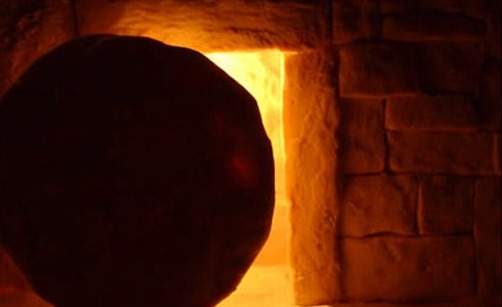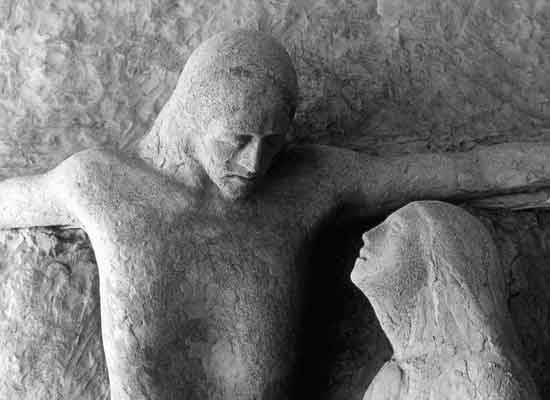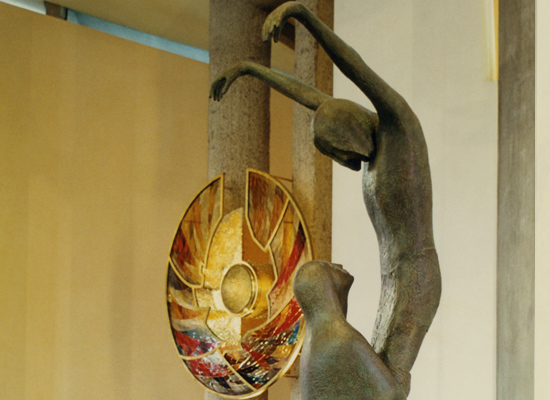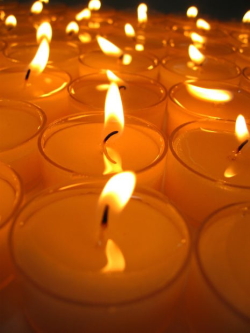
Mar 27, 2016 | Non categorizzato
 “A providential circumstance led me to examining in depth the reality of Jesus who, after his abandonment and death on the cross, rose from the dead. Not only, but I had the opportunity to meditate intensely with my mind and heart on many details of Jesus’ resurrection and on his life after the resurrection. I was dumbfounded (this is the exact word) at the majesty, the magnificence that emanated from this divine event, by the uniqueness of the risen Lord, by this supernatural fact which, as far as I know, is unique in the world. For this reason, I cannot help but highlight it again this time. … The resurrection is what most characterizes Christianity, what distinguishes Jesus, its founder. The fact that he is risen! Risen from the dead! Not in the way that others rose, like Lazarus, for instance, who then, when his time came, died. Jesus is risen never to die again. He continues to live, also as a man, in heaven, in the heart of the Trinity. Five hundred people saw him! And he certainly wasn’t a ghost. It was him, really him. He told Thomas, “Put your finger here and see my hands. Reach out your hand and put it into my side” (Jn 20:27). He ate with his disciples; he spoke with them; he stayed with them for as long as forty days. He had renounced his infinite greatness out of love for us and he had made himself small, a man among men, like one of us. … In rising from the dead, he broke, he surpassed, all the laws of nature, of the entire cosmos and, by doing so, he showed that he is greater than all that exists, greater than all that he created, greater than all that can be imagined. Consequently, even if we have just an intuition of this truth, we cannot help but see him as God. We cannot help but do as Thomas did and fall down on our knees in adoration before him, confessing in all sincerity: “My Lord and my God.” … And I saw with new eyes what he did during those fabulous new days on earth. After an angel came down from heaven, overturned the stone of his sepulchre and announced his resurrection, the risen Lord appeared first of all to Mary Magdalene, the former sinner, because he had become man for sinners. Then we find him walking along the road to Emmaus. Great and immense as he was, he becomes the first exegete and explains the Scriptures to the two disciples. Then we see him as the founder of his Church, laying his hands on his disciples to give them the Holy Spirit; we hear him saying extraordinary words to Peter whom he places as the head of his Church. Then he sends the disciples into the world to announce the Gospel, the new Kingdom he founded in the name of the Most Holy Trinity from where he descended and to where, with his coming ascension, he will return. … And, because he is risen, the words he said to us before his death acquire unique brilliance and express indisputable truths. First and foremost, the words announcing the fact that we too will rise. I knew it and believed it before, because I am a Christian. But now I am doubly sure: I will rise, we will rise. …” Chiara Lubich, In unità verso il Padre, Città Nuova editrice, Roma 2004, p.102-105
“A providential circumstance led me to examining in depth the reality of Jesus who, after his abandonment and death on the cross, rose from the dead. Not only, but I had the opportunity to meditate intensely with my mind and heart on many details of Jesus’ resurrection and on his life after the resurrection. I was dumbfounded (this is the exact word) at the majesty, the magnificence that emanated from this divine event, by the uniqueness of the risen Lord, by this supernatural fact which, as far as I know, is unique in the world. For this reason, I cannot help but highlight it again this time. … The resurrection is what most characterizes Christianity, what distinguishes Jesus, its founder. The fact that he is risen! Risen from the dead! Not in the way that others rose, like Lazarus, for instance, who then, when his time came, died. Jesus is risen never to die again. He continues to live, also as a man, in heaven, in the heart of the Trinity. Five hundred people saw him! And he certainly wasn’t a ghost. It was him, really him. He told Thomas, “Put your finger here and see my hands. Reach out your hand and put it into my side” (Jn 20:27). He ate with his disciples; he spoke with them; he stayed with them for as long as forty days. He had renounced his infinite greatness out of love for us and he had made himself small, a man among men, like one of us. … In rising from the dead, he broke, he surpassed, all the laws of nature, of the entire cosmos and, by doing so, he showed that he is greater than all that exists, greater than all that he created, greater than all that can be imagined. Consequently, even if we have just an intuition of this truth, we cannot help but see him as God. We cannot help but do as Thomas did and fall down on our knees in adoration before him, confessing in all sincerity: “My Lord and my God.” … And I saw with new eyes what he did during those fabulous new days on earth. After an angel came down from heaven, overturned the stone of his sepulchre and announced his resurrection, the risen Lord appeared first of all to Mary Magdalene, the former sinner, because he had become man for sinners. Then we find him walking along the road to Emmaus. Great and immense as he was, he becomes the first exegete and explains the Scriptures to the two disciples. Then we see him as the founder of his Church, laying his hands on his disciples to give them the Holy Spirit; we hear him saying extraordinary words to Peter whom he places as the head of his Church. Then he sends the disciples into the world to announce the Gospel, the new Kingdom he founded in the name of the Most Holy Trinity from where he descended and to where, with his coming ascension, he will return. … And, because he is risen, the words he said to us before his death acquire unique brilliance and express indisputable truths. First and foremost, the words announcing the fact that we too will rise. I knew it and believed it before, because I am a Christian. But now I am doubly sure: I will rise, we will rise. …” Chiara Lubich, In unità verso il Padre, Città Nuova editrice, Roma 2004, p.102-105

Mar 26, 2016 | Non categorizzato

Ave Cerquetti, ‘Crucifixion’ – Lienz (Austria) 1975

Mar 25, 2016 | Non categorizzato

©Ave Cerquetti, ‘L’unico Bene’ – Mariapolis Ginetta (Brazil) 1998

Mar 24, 2016 | Non categorizzato
 “The orientation of the Gospel of St. John, and also the others, converge in the phrase which has lately taken on a deep and infinite meaning for me: “That they all be one, as you Father are in me and I in you, so that the world may believe.” (John 17,21). This is how we should live. […] These are the coordinates of the unity that is particularly dear to me: unity in our parishes, unity in the various services and ministries, unity between the clergy and the laity, and between presbyteries. Unity becomes credible only if it demonstrates that we are not the patrons, but that only He is the Lord. This unity in the context of priestly ministry is something I particularly hold dear. Likewise I must mention unity of the Church, unity with those who are outside the confines of our Roman-Catholic Church, unity among all those who identify themselves with faith in the only God, the Living God and, therefore, with the Jews and Muslims. That unity between the Church and society is where one does not run parallel to or contrast with the other, but where the Church and society enter into a mutual relationship, bringing to light that unity which God gives for leavening society, with that leaven which makes man free. It is unity that makes man fully man, since he can become man in the full sense only where God has the right to be fully God, and thus can endow us with all He wishes to give us. And He wants to give us nothing less than His intimate mystery: Trinitarian unity. But this is not a simple plan, since we do not progress much only with plans. Instead it has to become life […]. Also I have to start living this unity. It is due to this that I trust the fact that all of you dear brothers and sisters can help me, and that we can do so mutually.” Bishop Klaus Hemmerle Cited from: W. Hagemann, Klaus Hemmerle. Innamorato della Parola di Dio. (In love with the Word of God), Città Nuova ed., Roma 2013, pp. 337-338
“The orientation of the Gospel of St. John, and also the others, converge in the phrase which has lately taken on a deep and infinite meaning for me: “That they all be one, as you Father are in me and I in you, so that the world may believe.” (John 17,21). This is how we should live. […] These are the coordinates of the unity that is particularly dear to me: unity in our parishes, unity in the various services and ministries, unity between the clergy and the laity, and between presbyteries. Unity becomes credible only if it demonstrates that we are not the patrons, but that only He is the Lord. This unity in the context of priestly ministry is something I particularly hold dear. Likewise I must mention unity of the Church, unity with those who are outside the confines of our Roman-Catholic Church, unity among all those who identify themselves with faith in the only God, the Living God and, therefore, with the Jews and Muslims. That unity between the Church and society is where one does not run parallel to or contrast with the other, but where the Church and society enter into a mutual relationship, bringing to light that unity which God gives for leavening society, with that leaven which makes man free. It is unity that makes man fully man, since he can become man in the full sense only where God has the right to be fully God, and thus can endow us with all He wishes to give us. And He wants to give us nothing less than His intimate mystery: Trinitarian unity. But this is not a simple plan, since we do not progress much only with plans. Instead it has to become life […]. Also I have to start living this unity. It is due to this that I trust the fact that all of you dear brothers and sisters can help me, and that we can do so mutually.” Bishop Klaus Hemmerle Cited from: W. Hagemann, Klaus Hemmerle. Innamorato della Parola di Dio. (In love with the Word of God), Città Nuova ed., Roma 2013, pp. 337-338

Mar 24, 2016 | Non categorizzato
 |
“Looking at this profoundly wounded world, unity and peace might seem just a dream.
May the power of the Risen Lord, who overcame death, every death, forever, strengthen in us the boldness to believe, hope and act so that fraternity may become the norm for shared living between different cultures and peoples.
I wish you all a Happy Easter, with the Risen Jesus in our midst!”
Maria Voce (Emmaus)
|

 “A providential circumstance led me to examining in depth the reality of Jesus who, after his abandonment and death on the cross, rose from the dead. Not only, but I had the opportunity to meditate intensely with my mind and heart on many details of Jesus’ resurrection and on his life after the resurrection. I was dumbfounded (this is the exact word) at the majesty, the magnificence that emanated from this divine event, by the uniqueness of the risen Lord, by this supernatural fact which, as far as I know, is unique in the world. For this reason, I cannot help but highlight it again this time. … The resurrection is what most characterizes Christianity, what distinguishes Jesus, its founder. The fact that he is risen! Risen from the dead! Not in the way that others rose, like Lazarus, for instance, who then, when his time came, died. Jesus is risen never to die again. He continues to live, also as a man, in heaven, in the heart of the Trinity. Five hundred people saw him! And he certainly wasn’t a ghost. It was him, really him. He told Thomas, “Put your finger here and see my hands. Reach out your hand and put it into my side” (Jn 20:27). He ate with his disciples; he spoke with them; he stayed with them for as long as forty days. He had renounced his infinite greatness out of love for us and he had made himself small, a man among men, like one of us. … In rising from the dead, he broke, he surpassed, all the laws of nature, of the entire cosmos and, by doing so, he showed that he is greater than all that exists, greater than all that he created, greater than all that can be imagined. Consequently, even if we have just an intuition of this truth, we cannot help but see him as God. We cannot help but do as Thomas did and fall down on our knees in adoration before him, confessing in all sincerity: “My Lord and my God.” … And I saw with new eyes what he did during those fabulous new days on earth. After an angel came down from heaven, overturned the stone of his sepulchre and announced his resurrection, the risen Lord appeared first of all to Mary Magdalene, the former sinner, because he had become man for sinners. Then we find him walking along the road to Emmaus. Great and immense as he was, he becomes the first exegete and explains the Scriptures to the two disciples. Then we see him as the founder of his Church, laying his hands on his disciples to give them the Holy Spirit; we hear him saying extraordinary words to Peter whom he places as the head of his Church. Then he sends the disciples into the world to announce the Gospel, the new Kingdom he founded in the name of the Most Holy Trinity from where he descended and to where, with his coming ascension, he will return. … And, because he is risen, the words he said to us before his death acquire unique brilliance and express indisputable truths. First and foremost, the words announcing the fact that we too will rise. I knew it and believed it before, because I am a Christian. But now I am doubly sure: I will rise, we will rise. …” Chiara Lubich, In unità verso il Padre, Città Nuova editrice, Roma 2004, p.102-105
“A providential circumstance led me to examining in depth the reality of Jesus who, after his abandonment and death on the cross, rose from the dead. Not only, but I had the opportunity to meditate intensely with my mind and heart on many details of Jesus’ resurrection and on his life after the resurrection. I was dumbfounded (this is the exact word) at the majesty, the magnificence that emanated from this divine event, by the uniqueness of the risen Lord, by this supernatural fact which, as far as I know, is unique in the world. For this reason, I cannot help but highlight it again this time. … The resurrection is what most characterizes Christianity, what distinguishes Jesus, its founder. The fact that he is risen! Risen from the dead! Not in the way that others rose, like Lazarus, for instance, who then, when his time came, died. Jesus is risen never to die again. He continues to live, also as a man, in heaven, in the heart of the Trinity. Five hundred people saw him! And he certainly wasn’t a ghost. It was him, really him. He told Thomas, “Put your finger here and see my hands. Reach out your hand and put it into my side” (Jn 20:27). He ate with his disciples; he spoke with them; he stayed with them for as long as forty days. He had renounced his infinite greatness out of love for us and he had made himself small, a man among men, like one of us. … In rising from the dead, he broke, he surpassed, all the laws of nature, of the entire cosmos and, by doing so, he showed that he is greater than all that exists, greater than all that he created, greater than all that can be imagined. Consequently, even if we have just an intuition of this truth, we cannot help but see him as God. We cannot help but do as Thomas did and fall down on our knees in adoration before him, confessing in all sincerity: “My Lord and my God.” … And I saw with new eyes what he did during those fabulous new days on earth. After an angel came down from heaven, overturned the stone of his sepulchre and announced his resurrection, the risen Lord appeared first of all to Mary Magdalene, the former sinner, because he had become man for sinners. Then we find him walking along the road to Emmaus. Great and immense as he was, he becomes the first exegete and explains the Scriptures to the two disciples. Then we see him as the founder of his Church, laying his hands on his disciples to give them the Holy Spirit; we hear him saying extraordinary words to Peter whom he places as the head of his Church. Then he sends the disciples into the world to announce the Gospel, the new Kingdom he founded in the name of the Most Holy Trinity from where he descended and to where, with his coming ascension, he will return. … And, because he is risen, the words he said to us before his death acquire unique brilliance and express indisputable truths. First and foremost, the words announcing the fact that we too will rise. I knew it and believed it before, because I am a Christian. But now I am doubly sure: I will rise, we will rise. …” Chiara Lubich, In unità verso il Padre, Città Nuova editrice, Roma 2004, p.102-105 




